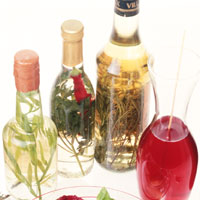health guides
Vinegar

Varieties
Today, there is a wide variety of vinegars to choose from. They include:
Apple-cider vinegar
This traditional cider vinegar is made from freshly pressed apple juice that is allowed to ferment over a four- to six-week period at room temperature. Strongly acidic, quality cider vinegar has a bright, crisp flavour and tastes like the apples from which it was pressed. Apple-cider vinegar is used in dressings, sauces, condiments, marinades, and pickles.
Balsamic vinegar
Originally produced only in Modena, Italy, balsamic vinegar is now made in many places, chiefly in California. The best balsamic vinegar is made only from Trebbiano grapes. With a taste blending both sweet and sour, it has a dark colour and is one of the most flavourful of vinegars. It can be sprinkled on cooked meats, salad greens, strawberries, peaches, and melons. There is also a white balsamic vinegar (a pale gold), which has a sharper twist to it than most darker balsamic varieties.
Malt vinegar
Made of sprouted and fermented barley, malt vinegar is too strongly flavoured for salad dressings. However, when it is distilled to a clear white, instead of amber brown, it is excellent for pickling, and in England it is liberally splashed over fish and chips.
Rice vinegar
This vinegar, distilled from rice, has less of a sharp tang than cider vinegar, and just a hint of sweetness. The Japanese use it in making rice for sushi, in dipping sauces, and to create many pickled dishes. It is also good for marinating tofu (with soya sauce and ginger), and in grain and bean salads. Widely used in Asian dishes, rice vinegar is popular because it does not significantly alter the appearance of the food.
Umeboshi vinegar
Umeboshi vinegar is a pink brine with a deep cherry aroma and a fruity, sour flavour. It is a by-product produced when umeboshi (Japanese pickled plums) is made. Technically, it is not classified as a vinegar because it contains salt, but it is a good substitute for vinegar and salt in any recipe. It has a light, citric flavour and lends itself well to salad dressings and adding flavour to steamed vegetables.
White distilled vinegar
This vinegar is strong, acidic, and too sharp for dressings and regular cooking. Use it sparingly, or substitute lemon, tomato, or grapefruit juice in recipes where white vinegar is called for.
Wine vinegar
Wine vinegar—made from red, white, or rose wines—is an excellent condiment. These vinegars may be used interchangeably. They are flavourful, fruity, and combine well with salads, sauces, and dressings.
Sometimes wine vinegars have fruit or herbs, such as raspberry or tarragon, added to them. Raspberry vinegar can be sprinkled on fruit salads, used as a marinade or basting sauce for meats, added to your favourite salad dressing, or used by itself on salads or cooked vegetables. Herb vinegars are especially useful in salads and savoury dishes.
In the Philippines and Indonesia, coconut and cane vinegars are popular, and in the Middle East, date vinegar is a favourite.
Copyright © 2024 TraceGains, Inc. All rights reserved.
Learn more about TraceGains, the company.
The information presented in the Food Guide is for informational purposes only and was created by a team of US–registered dietitians and food experts. Consult your doctor, practitioner, and/or pharmacist for any health problem and before using any supplements, making dietary changes, or before making any changes in prescribed medications. Information expires December 2024.


 We are proud to announce that
We are proud to announce that  As the market evolves, customers increasingly request a wider variety of omega-3 options for their lipid...
As the market evolves, customers increasingly request a wider variety of omega-3 options for their lipid...  Maintaining healthy glucose levels is crucial for preventing metabolic conditions like diabetes,...
Maintaining healthy glucose levels is crucial for preventing metabolic conditions like diabetes,...  Looking at formulating a new vitamin blend? Discover
Looking at formulating a new vitamin blend? Discover 







































